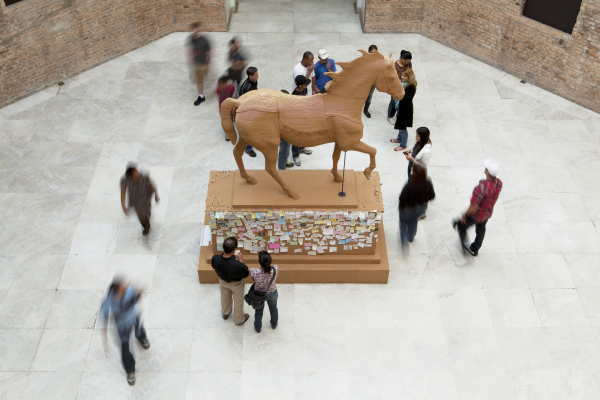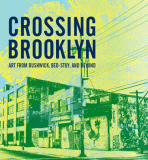
Paul Ramírez Jonas (Honduran American, b. 1965). The Commons, 2011. Cork, pushpins, notes contributed by the public, 153 × 128 × 64 in. (388.6 × 135.1 × 162.6 cm). Courtesy of the artist and Koenig & Clinton Gallery. © Paul Ramírez Jonas. Photo Paul Ramírez Jonas

Paul Ramírez Jonas (Honduran American, b. 1965). The Commons, 2011. Cork, pushpins, notes contributed by the public, 153 × 128 × 64 in. (388.6 × 135.1 × 162.6 cm). Courtesy of the artist and Koenig & Clinton Gallery. © Paul Ramírez Jonas. Photo Paul Ramírez Jonas

Gordon Hall (American, b. 1983). “Read me that part a-gain, where I disin-herit everybody,” 2014. Wood, paint, and performance-lecture with projected images and colored light, dimensions variable. Commissioned by EMPAC/Experimental Media and Performance Arts Center, Rensselaer Polytechnic Institute, Troy, New York. Courtesy of the artist. © Gordon Hall. Photo: Ryan Jenkins
Gordon Hall is founder and director of the Center for Experimental Lectures, a series of curated lecture-performances that consider the lecture format itself a creative medium. Titled after a quotation from artist-composer John Cage’s 1959 “Lecture on Nothing,” “Read me that part a-gain, where I disin-herit everybody” operates as both a static artwork and an active stage for Hall’s own lecture-performances. These performances explore, in Hall’s words, “the possibilities created and foreclosed by different kinds of platforms, from furniture to politics.” They combine sculptural objects, sound (in the form of a text written and read by the artist on the history of lecture-performance), projected images, and physical action as Hall moves among, on top of, and around the objects.

Deana Lawson (American, b. 1979). As Above, So Below, 2014. Pigment print, 441⁄2 x 35 in. (111.8 × 88.9 cm). Courtesy of the artist and Rhona Hoffman Gallery. © Deana Lawson
In the photographs on view, taken in Brooklyn, Haiti, Jamaica, and Miami, Deana Lawson depicts her subjects with a deeply intimate and gentle eye. Though she shoots in diverse settings, and her subjects are most often strangers, Lawson’s works are united by what she calls the “familial gaze.” She is inspired by the expression and aesthetics of black cultures worldwide, and her photographs can be seen as psychological portraits of black subjects in an extended, mythological diasporic family. Using a large-format camera, and working across a variety of photographic traditions, including portraiture, staged scenes, found or appropriated imagery, and vernacular photography (e.g., family albums), she addresses themes of the body, sensuality, community, and spirituality, among others.

Marie Lorenz (American, b. 1973). Archipelago (Mast View), 2012. HD video. Courtesy of the artist and Jack Hanley Gallery. © Marie Lorenz. Photo: Marie Lorenz
For the installation Archipelago, Marie Lorenz traveled New York City’s waterways from Barren Island in Jamaica Bay to her home in Bushwick in a plywood and fiberglass boat she designed and built herself. With cameras connected to both her body and the boat, she captured three different views of the same route. Considering the tide a collaborator, she collected objects it had “arranged” along the shore to add to the installation. By presenting unusual perspectives that bob, float, hover, and expand our field of vision, the work invites us to see the city anew.
In a related ongoing project she calls The Tide and Current Taxi, Lorenz also takes passengers out in New York Harbor in a rowboat, documenting the trips in picture and story at www.tideandcurrenttaxi.org.

Duke Riley (American, b. 1972). Pigeon Loft, 2012–13. Reclaimed wood; roofing and construction materials, 168 × 120 × 72 in. (426.7 × 304.8 × 182.9 cm). Collection of Laura Lee Brown and Steve Wilson, 21c Museum, Louisville, Kentucky. © Duke Riley. Photo: Zach Callahan
For Trading with the Enemy, Duke Riley spent eight months breeding and training a flock of homing pigeons in order to transport illicit cigars from Havana, Cuba, to Key West, Florida. Homing pigeons are not detectable by the high-tech surveillance systems used by the United States to monitor international waters, nor can they be prosecuted for smuggling.
Of the twenty-three pigeons that set off from Havana, eleven returned safely to Key West from the more than 100-mile journey. Each pigeon wore a carrying device the artist handcrafted out of bra straps. Half the birds, named for notorious smugglers, carried cigars, while the other half, named for famous filmmakers who got in trouble with the law, carried specially designed lightweight cameras to record the flight. A video with the footage they filmed is on view along with the pigeon loft Riley built in Key West, which houses several live pigeons. The pigeons have been given a clean bill of health by a veterinarian and will be cared for throughout the exhibition by trained specialists.

Nina Katchadourian (American, b. 1968). Topiary (from the Seat Assignment series), 2012. C-print, 451⁄2 x 351⁄2 in. (115.6 × 90.2 cm). Courtesy the artist and Catharine Clark Gallery. © Nina Katchadourian
The Seat Assignment series (2010–ongoing), of which this is only a small part, consists of site-specific installations, photographs, video, and sound works all made by Nina Katchadourian while on airplanes—more than a hundred flights to date. The rules are simple but absolute: she works alone and spontaneously, with only her camera phone and the materials and locations at hand (airline magazines, in-flight snacks, tray tables, airplane lavatories, toilet-seat covers, her own clothing, etc.). The series stems, in her words, from “an investment in thinking on your feet, optimism about the artistic potential that lurks within the mundane, and curiosity about the productive tension between freedom and constraint.”

Linda Goode Bryant (American, b. 1949) and Project EATS. Moving Compost (Amboy Garden Farm, Brownsville, Brooklyn), 2013. Compost, soil, wheelbarrows, shovels, community resident participation, 25 cubic yards of compost spread over 2,226 square feet of land. Project EATS, © Active Citizen Project. Photo: Linda Goode Bryant, Active Citizen Project
ItNot#2-Brooklyn: This is not me. It’s who I became (2014) is a site-specific installation made up of three components on the Museum’s grounds: vegetable gardens, a weekly green market, and an “Energy Hub” station where you can pedal a bicycle to generate power for future use by Project EATS at their urban farms in Brownsville (pictured here) and East New York, Brooklyn.
Based on the idea that people can create what they need with what they have, Project EATS is what founder Linda Goode Bryant calls an ArtAction, a “documentary story” focusing on the need for nutritious food in economically disadvantaged urban neighborhoods. Project EATS is a program of the Active Citizen Project, which promotes new modes of public thought and social action.

Brendan Fernandes (Canadian, b. Kenya, 1979). 1979.206.200, 2010. Neon on glass frame, 34 × 26 in. (86.4 × 66 cm.). Courtesy of the artist. © Brendan Fernandes. Photo: Erika Neola and Brendan Beecy
Looking at the cultural economy of African masks—from the vendors on Canal Street selling cheap fetishized replicas, to the decontextualization of African masks in cultural institutions—Brendan Fernandes investigates linguistic and economic aspects of the Western consumption of African art.
The three neon sculptures on view, which flicker in Morse code, are inspired by three masks by unknown artists in the Metropolitan Museum of Art’s collection and titled after the museum’s accession numbers for those works. The wall vinyl exhibited with them refers to one of the few traditional African artists identified by European scholars, who has been given the name the Master of Buli after a village in the Democratic Republic of Congo. Both the sculptures and the vinyl employ Morse code to ask, among other things, who is the Master of Buli and what is the power of naming?

Cynthia Daignault (American, b. 1978). I love you more than one more day, 2013. Oil on linen, 365 paintings: 10 × 15 in. (25.4 × 38.1 cm) each; overall dimensions variable. Installation view: Which Is the Sun and Which Is the Shadow?, Lisa Cooley, New York, 2013. Collection of Marsha and John Kleinheinz, Fort Worth, Texas. Courtesy of the artist and Lisa Cooley, New York © Cynthia Daignault. Photo: John Berens
On July 25, 2012, Cynthia Daignault began a yearlong project of making a daily record of the sky. Contemplating time—doing time, spending time, the passing of time—she then drew from this assembled collection of charcoal sketches, pencil drawings, pastels, and photographs to produce a painting for each day of the year, working twelve hours a day, every day, until all 365 were finished—a process that took an additional three months.
Installed in chronological order, the resulting panorama is all-encompassing, compressing an expanse of time and effort into a single moment. The work’s title is drawn from a line in Joan Didion’s 2005 memoir The Year of Magical Thinking. Like that book, an account of the year following the death of Didion’s husband, Daignault’s project addresses the presence of those who are absent, as well as notions of life and death—the room as afterlife, memory, omniscient vision.

Nobutaka Aozaki (Japanese, b. 1977). Smiley Bag Portrait, 2011. Participatory performance. Courtesy of the artist. © Nobutaka Aozaki. Photo: Xiaotian Yang
Nobutaka Aozaki regularly invites New York City pedestrians to sit for a free portrait. Though inspired by the sidewalk portrait artists at popular tourist sites like Times Square and Central Park, his portraits are decidedly different. Thanks to his chosen media—Sharpie marker on smiley face–emblazoned plastic bag, frequently used for takeout in New York—his subjects are unified by their smiles, though details of individual style are noted. In this and other works, he incites strangers to first become audience members and then participants. As he says, “My work cannot be made without you.”
Crossing Brooklyn: Art from Bushwick, Bed-Stuy, and Beyond
October 3, 2014–January 4, 2015
Reflecting the rich creative diversity of Brooklyn, Crossing Brooklyn presents work by thirty-five Brooklyn-based artists or collectives. The exhibition and related programming take place in the galleries and on the grounds of the Museum, as well as off-site in the streets, waterways, and other public spaces of the borough.
Emphasizing artistic practices that engage with the world, the exhibition includes artists who aim to expand their focus and have an impact beyond the studio and the museum. The resulting work defies easy categorization, taking on diverse forms that include public and private action, the use of found or collected objects, and interactive and educational events, among others. Alongside the drawings, paintings, photographs, sculptures, installations, videos, and performances on view are several site-specific works.
While acknowledging Brooklyn’s heightened profile, Crossing Brooklyn presents a multigenerational picture that recognizes the borough’s long-established role as a creative center. Other themes explored in the exhibition include history and memory, place and geography, community, nostalgia, exchange, ephemerality, and politics, both local and remote.
The artists included in this exhibition are Yuji Agematsu, Janine Antoni, Nobutaka Aozaki, Daniel Bejar, BFAMFAPhD (Julian Boilen, Susan Jahoda, Blair Murphy, Vicky Virgin, Lika Volkova, and Caroline Woolard), Linda Goode Bryant and Project EATS, Aisha Cousins, Cynthia Daignault, Elastic City (Todd Shalom), Zachary Fabri, Brendan Fernandes, Gordon Hall, Drew Hamilton, Heather Hart, Pablo Helguera, David Horvitz, Yoko Inoue, Steffani Jemison, Matthew Jensen, Nina Katchadourian, McKendree Key, William Lamson, Deana Lawson, Shaun Leonardo, Marie Lorenz, Miguel Luciano, Shantell Martin, Mary Mattingly, Kambui Olujimi, Paul Ramírez Jonas, Duke Riley, Lisa Sigal, Xaviera Simmons, Tatlo (Sara Jimenez, Michael Watson, and Jade Yumang), and Bryan Zanisnik.
Crossing Brooklyn: Art from Bushwick, Bed-Stuy, and Beyond is organized by Eugenie Tsai, John and Barbara Vogelstein Curator of Contemporary Art, and Rujeko Hockley, Assistant Curator of Contemporary Art, Brooklyn Museum. A catalogue including a roundtable conversation among several longtime Brooklyn artists accompanies the exhibition.





